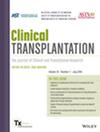Posttransplant Lymphoproliferative Disease Following Pancreas Transplantation: A 40 Year Single-Center Experience
Abstract
Background
Chronic immunosuppression following pancreas transplantation carries significant risk, including posttransplant lymphoproliferative disease (PTLD). We sought to define the incidence, risk factors, and long-term outcomes of PTLD following pancreas transplantation at a single center.
Methods
All adult pancreas transplants between February 1, 1983 and December 31, 2023 at the University of Minnesota were reviewed, including pancreas transplant alone (PTA), simultaneous pancreas–kidney transplants (SPK), and pancreas after kidney transplants (PAK).
Results
Among 2353 transplants, 110 cases of PTLD were identified, with an overall incidence of 4.8%. 17.3% were diagnosed within 1 year of transplant, 32.7% were diagnosed within 5 years, and 74 (67.3%) were diagnosed after 5 years. The overall 30-year incidence of PTLD did not differ by transplant type—7.4% for PTA, 14.2% for SPK, and 19.4% for PAK (p = 0.3). In multivariable analyses, older age and Epstein-Barr virus seronegativity were risk factors for PTLD, and PTLD was a risk factor for patient death. PTLD-specific mortality was 32.7%, although recipients with PTLD had similar median posttransplant survival compared to those without PTLD (14.9 year vs. 15.6 year, p = 0.9).
Conclusions
PTLD following pancreas transplantation is associated with significant mortality. Although the incidence of PTLD has decreased over time, a high index of suspicion for PTLD following PTx should remain in EBV-negative recipients.

 求助内容:
求助内容: 应助结果提醒方式:
应助结果提醒方式:


